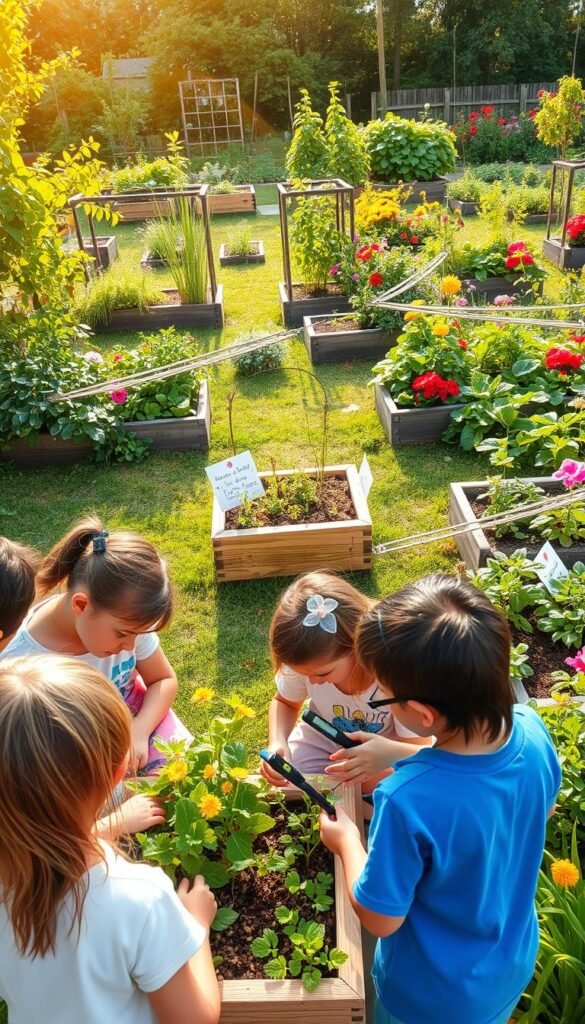What if your backyard could become a vibrant space where children explore core academic concepts without textbooks? Outdoor spaces offer fresh opportunities to connect classroom subjects with real-world applications. When young learners dig into soil or measure plant growth, abstract ideas suddenly click through tangible experiences.
A well-planned garden transforms into a dynamic learning lab. Here, kids practice measuring rainfall, track growth patterns, and solve spatial challenges while arranging plants. These activities naturally reinforce geometry, data analysis, and environmental science principles. Best of all? They’ll hardly realize they’re building academic skills as they nurture seedlings.
Research shows hands-on gardening helps young minds retain information 40% longer than traditional methods. By interacting with living systems, children grasp complex concepts like photosynthesis or nutrient cycles through direct observation. This approach also fosters responsibility as they care for plants from seed to harvest.
You’ll create more than just a vegetable patch. Your outdoor space becomes a multisensory education hub where curiosity blossoms alongside flowers. As kids calculate plot dimensions or document insect behavior, they gain confidence applying classroom theories to meaningful projects. The lessons learned here will root deeply, growing with them long after the season ends.
Getting Started with Your Learning Garden
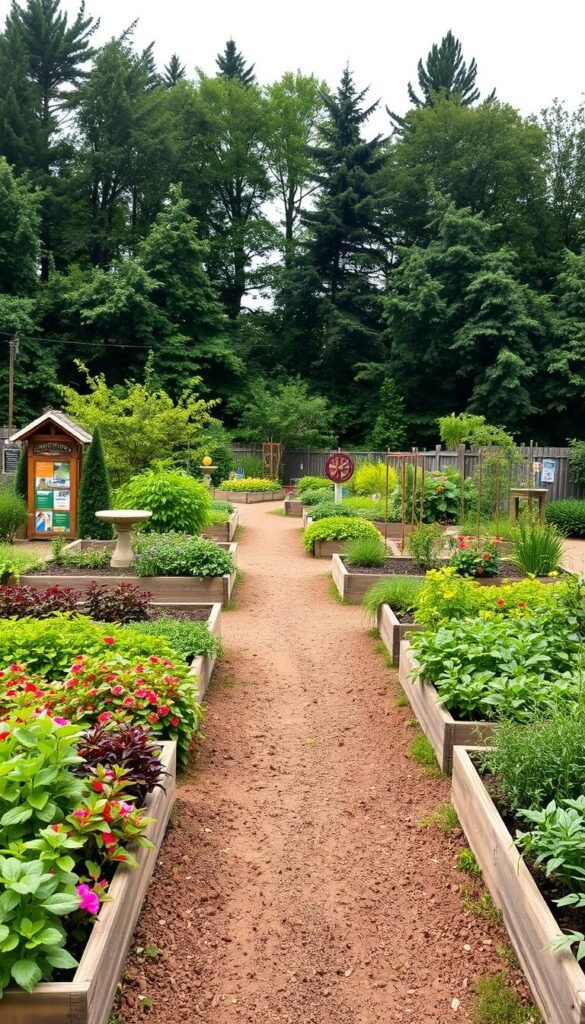
Transform your outdoor area into a living classroom by selecting a space that sparks curiosity. Begin with three key elements: sunlight access, easy water sources, and room for exploration. Let young explorers test soil quality using simple pH strips – their first hands-on science moment!
Choosing the Ideal Garden Layout
Shape matters more than you think! Compare different configurations using this quick guide:
| Shape | Best For | Space Efficiency |
|---|---|---|
| Square | Leafy greens | High |
| Rectangular | Climbing plants | Medium |
| Triangular | Herb spirals | Creative |
“The right design turns dirt into data,” notes school garden coordinator Maria Torres. Involve participants in measuring angles between plant rows – practical geometry lessons emerge naturally.
Gathering Essential Gardening Supplies
Build your toolkit with multi-purpose items:
- Rain gauges doubling as liquid measurement tools
- Colored stakes for mapping plant locations
- Transparent containers for root growth observation
Calculate seed quantities together using plant spacing charts. Young planners quickly grasp multiplication concepts when determining how many tomato seedlings fit in a 4×4 bed. Keep a shared journal nearby for sketching designs and tracking progress.
Designing Your Educational Garden Space
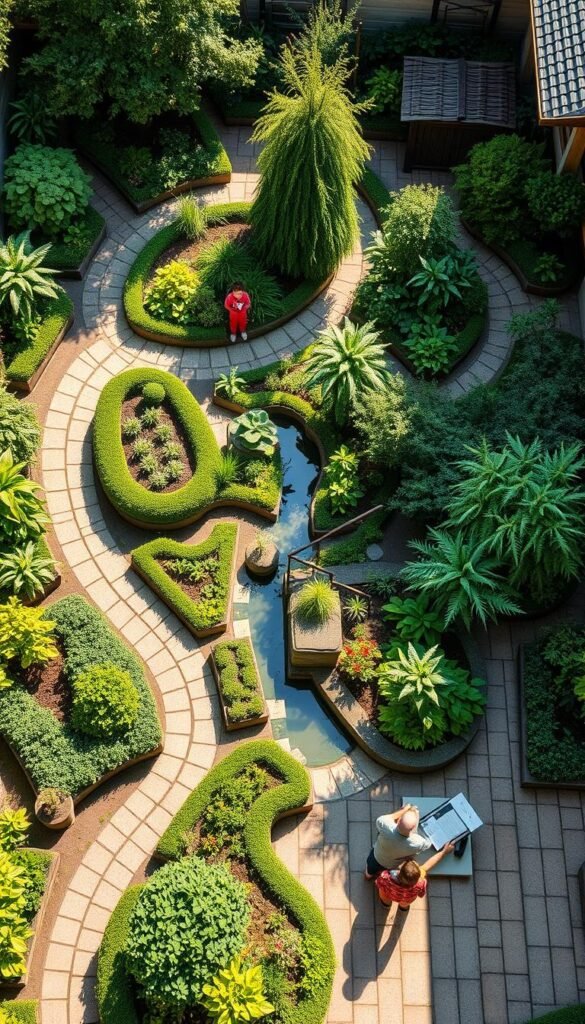
Imagine shaping a living blueprint where every measurement sparks discovery. This phase turns empty plots into interactive learning zones that merge creativity with critical thinking. Start by handing young designers graph paper and rulers – their tools for transforming ideas into tangible plans.
Sketching the Garden Design
Graph paper becomes a playground for spatial reasoning. As children draft layouts, they grasp scale by converting real-world dimensions into inches. A 4-foot bed might become 4 squares on paper, teaching proportional relationships. Challenge them to arrange plants considering companion species – basil beside tomatoes, marigolds near squash.
Considering Sunlight, Soil, and Space
Three factors dictate your garden’s success:
- Sunlight patterns: Track shadows hourly using chalk outlines
- Soil composition: Mix sand, silt, and clay samples in jars
- Growth spacing: Calculate mature plant widths using seed packets
“Soil tests reveal nature’s recipe book,” explains urban agriculture expert Lila Chen. Have young scientists record pH levels and drainage rates in field journals. These observations become springboards for discussing why carrots thrive in loose earth but lettuce prefers richer dirt.
For schools developing comprehensive programs, connecting outdoor spaces to classroom learning yields remarkable results. When garden beds mirror geometric concepts from textbooks, abstract ideas take root through physical creation. The final layout isn’t just about aesthetics – it’s a functional ecosystem designed by curious minds.
Exploring Science Through Hands-On Garden Experiments
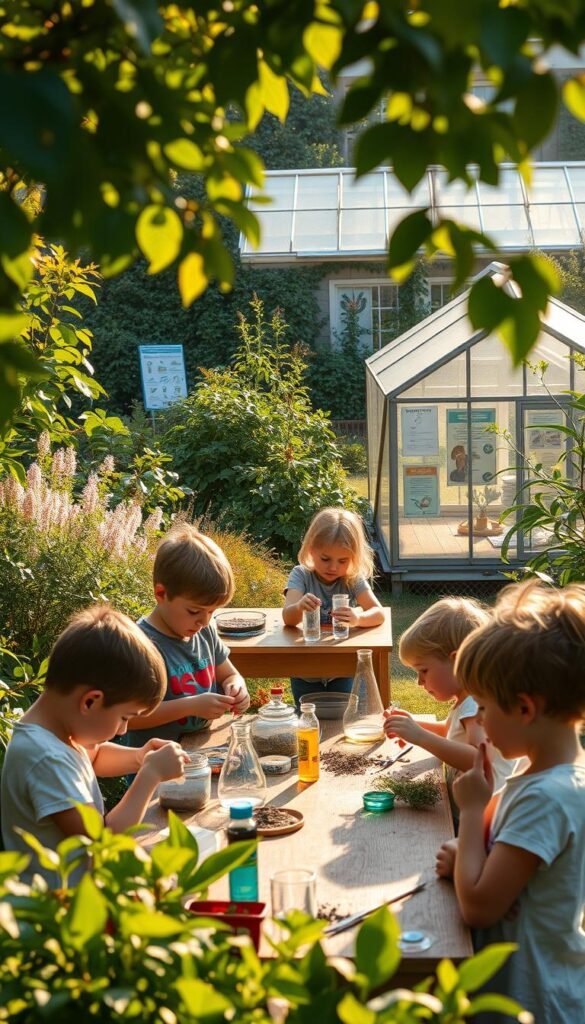
Dirt becomes a discovery zone when children approach it like scientists. Your garden transforms into an interactive lab where curiosity fuels exploration. Every shovel scoop and leaf inspection reveals nature’s hidden patterns.
Understanding Plant Biology and Soil Science
Start with seeds as living time capsules. Kids witness life cycles unfold as sprouts emerge, stretch toward sunlight, and develop flowers. Compare how beans climb poles while radishes push downward – perfect for discussing root systems.
Dig deeper with soil analysis. Use vinegar-baking soda tests to identify alkaline or acidic earth. Magnifying glasses reveal sand particles, decomposed leaves, and wiggling worms. “Different dirt types act like unique recipes for plants,” explains a young gardener during a compost investigation.
Conducting Simple Science Experiments
Set up side-by-side trials to make concepts tangible:
- Grow basil in sunny vs. shaded spots
- Water identical seedlings with varying amounts
- Cover some plants to block pollinators
Track changes daily using rulers and sketchpads. These experiments turn abstract ideas like photosynthesis into visible processes. When leaves yellow without light, the “why” clicks instantly.
Tracking Plant Growth Over Time
Create growth journals with weekly entries. Measure stem heights, count new leaves, and document flower development. Chart data on graph paper to visualize patterns. Over six weeks, a sunflower’s rapid growth demonstrates exponential change better than any textbook diagram.
Encourage predictions: “How tall will our corn get by July?” Compare estimates with actual results. This practice builds analytical thinking while making science feel like an exciting detective game.
Harnessing Math Concepts in Garden Projects
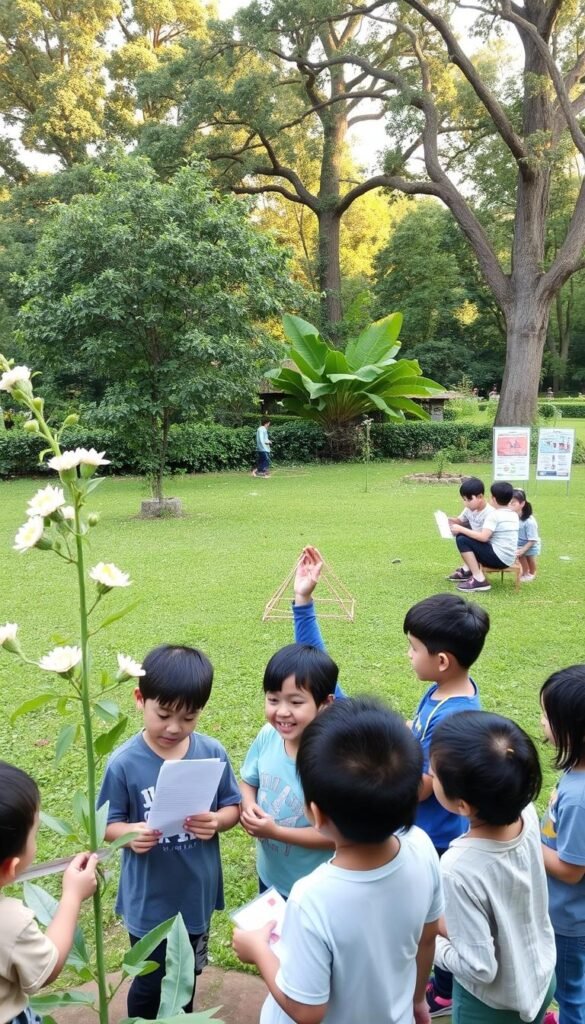
Turn soil into a calculator and sunflowers into rulers. Your outdoor space becomes a numbers playground where calculations feel like treasure hunts. Watch eyes light up as abstract equations transform into tools for solving actual challenges.
Measuring Garden Plots and Calculating Areas
Hand out measuring tapes and let explorers map their domain. A 6×8 foot bed isn’t just a rectangle – it’s 48 square feet of problem-solving potential. Convert inches to centimeters while planning herb spirals or circular flower patches.
| Tool | Math Skill | Real-World Use |
|---|---|---|
| Ruler | Linear measurement | Seed spacing |
| Protractor | Angles | Trellis construction |
| Rain gauge | Volume tracking | Water needs |
Applying Real-World Math Problems
Pose juicy questions that demand dirt-under-fingernails answers. “If we want 90 tomatoes and each plant gives 30, how many seedlings do we need?” becomes a mission rather than homework. Convert seed packet instructions into ratio puzzles.
| Scenario | Operation | Learning Outcome |
|---|---|---|
| 60 cm between squash plants | Division | Spatial reasoning |
| 3 seeds per hole x 15 holes | Multiplication | Resource planning |
| Total yield predictions | Algebra | Data analysis |
One group discovered why units matter after mixing feet and meters in their calculations – their carrots grew closer than expected! These “oops” moments become powerful lessons.
For families exploring gardening with kids, math naturally blends with responsibility. When young planners determine how many lettuce heads fit in a 4×2 meter bed, they’re not just doing arithmetic – they’re becoming problem-solvers.
Integrating Engineering and Technology in Your Garden

Watch young minds light up as they blend construction skills with data-driven discoveries. Your outdoor space becomes an innovation hub where problem-solving meets playful experimentation. Here, every project combines physical building with digital insights for smarter plant care.
Building Raised Beds and Trellises
Hand children tape measures and watch geometry come alive. Constructing wooden frames teaches practical math through angled cuts and board measurements. A 4-foot bed becomes a real-world puzzle – how many 8-inch planks fit per side?
Create climbing structures using recycled materials. Old bicycle wheels transform into pea trellises, while bamboo poles form bean teepees. These activities demonstrate how engineering solves growth challenges. “Our cucumber tower doubled yields!” reports a 10-year-old builder from Ohio.
Using Smart Garden Tools and Gadgets
Upgrade traditional tools with tech helpers. Soil moisture sensors send alerts when plants thirst, while weather stations track microclimates. Compare digital readings with finger-in-dirt tests – which method predicts watering needs better?
- Program drip systems using timer apps
- Chart growth rates with photo comparison software
- Test light levels using smartphone sensors
Early learners thrive when combining hands-on STEM projects with instant data feedback. For younger explorers, preschool gardening themes lay groundwork for future tech integration through simple measuring cups and growth charts.
Infusing Creativity with Art and Literacy Activities
Transform ordinary stones into storytelling tools and watch young imaginations blossom. Your outdoor space becomes a canvas where creativity meets practical learning, blending colorful expression with foundational skills. These activities turn leafy corners into interactive galleries buzzing with discovery.
Crafting Garden Art for Plant Identification
Hand out paintbrushes and smooth rocks to create nature’s nametags. As children decorate markers for basil or sunflowers, they practice letter shapes while discussing plant needs. Vibrant patterns on stones become visual cues that reinforce species recognition.
| Material | Art Project | Skills Developed |
|---|---|---|
| Rocks | Painted labels | Fine motor control |
| Recycled containers | Weatherproof signs | Letter recognition |
| Clay | 3D plant markers | Spatial reasoning |
Storytelling and Journaling Your Garden Journey
Supply sketchbooks for daily observations and invented tales. A sprouting carrot might become the hero in a story about perseverance, while wilting lettuce sparks discussions about problem-solving. “Journaling turns fleeting moments into lasting development milestones,” shares educator Tomas Rivera.
Encourage weekly entries mixing drawings with written notes. Young authors measure stem growth in sketches, then describe changes using vivid adjectives. This fusion of art and literacy strengthens both technical skills and emotional connections to plants.
Through these blended activities, your garden becomes a stage where children express ideas while absorbing scientific truths. Every painted stone and journal entry roots knowledge deeper, cultivating both academic growth and personal pride.
Teaching Math & Science with Kids’ Gardening Projects
Data transforms into discovery when young hands chart nature’s patterns. Your outdoor space becomes a living spreadsheet where numbers tell stories about thriving plants and seasonal changes. Through structured observation, learners connect abstract concepts to tangible results.
Numbers Come Alive in Soil
Hand rulers to children and watch measurement skills blossom. Tracking beanstalk heights weekly teaches incremental growth concepts. Calculate seed spacing using multiplication tables – 30 cm between pumpkins becomes 3×10 rather than random guessing.
Transform harvest yields into pie charts showing tomato vs. zucchini production. Colorful graphs make ratios visual and memorable. One group discovered their kale grew 2.5x faster in compost-rich soil – math proved nature’s preferences!
Nature’s Laboratory Reveals Secrets
Set up side-by-side experiments with intentional variables. Compare sunflower growth in clay vs. sandy soil using pH test kits. Document findings in journals with sketches and weather notes.
Through mini-science experiments, young researchers learn hypothesis testing. Why did shaded basil stay smaller? How did talking to plants affect their growth? Every question sparks analytical thinking.
Encourage teams to present findings using collected data. When rainfall charts explain why carrots split, science becomes a tool for solving mysteries. These activities nurture both critical thinking and environmental stewardship.
Engaging Young Minds with Interactive STEM Activities
Unlock nature’s secrets through playful investigations that turn your garden into a puzzle-filled wonderland. These hands-on activities spark curiosity while building essential STEM skills. Young explorers become detectives, engineers, and scientists as they tackle real-world challenges among the plants.
Garden Detective Activities and Clue Matching
Create mystery-solving kits with seed packets, measuring tapes, and clue cards. Children work in teams to match seedlings with their ideal growing conditions. A sunflower sprout might need “full sun” and “60 cm spacing” clues – perfect for discussing photosynthesis and spatial reasoning.
| Clue Type | Skill Developed | Sample Task |
|---|---|---|
| Sunlight cards | Pattern recognition | Mapping shady vs. sunny zones |
| Size rulers | Measurement analysis | Predicting plant spread |
| Water icons | Data interpretation | Creating watering schedules |
Interactive Problem-Solving Tasks
Present authentic challenges like “How many carrot seedlings fit in this bed?” Teams measure soil plots, calculate spacing needs, and debate solutions. Wrong guesses become learning moments when overcrowded plants struggle to thrive.
Encourage hypothesis testing with simple experiments. Will basil grow taller if watered morning vs. evening? Track results using growth charts and weather data. These activities make the scientific method tangible through dirt-smudged hands and excited discoveries.
Through collaborative problem-solving, young minds connect classroom concepts to living systems. They’ll remember dividing fractions better after calculating exactly how many marigolds border their tomato patch. Every solved mystery plants seeds for lifelong critical thinking.
Wrapping Up Your Garden Learning Journey
Your green space evolves into more than dirt and leaves – it becomes a launchpad for lifelong curiosity. Through hands-on exploration, children gain confidence as they solve real challenges like spacing seedlings or troubleshooting yellow leaves. These victories stick because they’re earned, not memorized.
Watching young minds connect classroom ideas to living plants reveals nature’s magic. Memories form deeper when counting pumpkin vines beats textbook equations. Knowledge takes root through daily interactions with soil textures and sun-seeking stems.
You’ll notice new skills blossoming beyond academics. Responsibility grows with each watering session, while patience emerges during growth waits. These lessons shape character as much as intellect, preparing explorers for future challenges.
Ready for more? Spark excitement with simple seed projects that turn windowsills into wonderlands. Every sprout becomes a living reminder – learning thrives where curiosity meets dirt.

